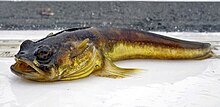Midshipman fish
| Midshipman fish Temporal range: Late Miocene to Present |
|
|---|---|
 |
|
| Plainfin midshipman (Porichthys notatus) | |
| Scientific classification | |
| Kingdom: | Animalia |
| Phylum: | Chordata |
| Class: | Actinopterygii |
| Order: | Batrachoidiformes |
| Family: | Batrachoididae |
| Genus: |
Porichthys Girard, 1854 |
| Species | |
|
See text. |
|
See text.
Midshipman fish belong to the genus Porichthys of toadfishes. They are distinguished by having photophores (which they use to attract prey and after which they are named, reminding some of a naval uniform's buttons) and four lateral lines. Typical midshipman fishes, such as the plainfin midshipman (Porichthys notatus), are nocturnal and bury themselves in sand or mud in the intertidal zone during the day. At night they float just above the seabed. Some species have venomous dorsal spines and are capable of inflicting serious injuries if handled.
There are three genders of midshipman fish: females, type I males, and type II males. Type I and type II males have different reproductive strategies, and can be distinguished from each other based on physical characteristics. Type I males are eight times larger in body mass, and have much larger vocal organs. Type II males’ reproductive organs are seven times larger in size than those of type I males. Female and type II male midshipman fish can be distinguished from each other by the female’s slightly larger size, and the type II male midshipman’s large reproductive organs.
There are currently 14 recognized species in this genus:
Mating in midshipman fishes depends on auditory communication. Male midshipman fish produce several different vocalizations while females only make grunts in non-breeding situations.
Typical Type I male calls are divided into short grunts that last for milliseconds or are produced in a series of grunts called a “grunt train,” mid-duration growls, and long duration advertisement hums that can last up to an hour. These calls can be recorded naturally. They can also be produced in a laboratory, a procedure known as “fictive calling.” In nature, two muscles contracting on the swim bladder produce these sounds. In the laboratory, sounds are produced by a stimulating electrode placed on the periaqueductal gray (PAG) and a recording electrode placed on the occipital nerve that leads to the sonic muscles of the fish.
The vocalizations of male midshipman fish are androgen and estradiol steroid mediated. There are high blood levels of these hormones during the transition from non-calling to calling before midshipman breeding season, suggesting that higher hormone levels are needed for making advertisement calls. Feeding 11-ketotestosterone coated scallops to toadfish increases their calling behavior, which identifies 11-ketotestosterone, an androgen hormone, as a mediator of midshipman fish vocalization. There are also high levels of aromatase, an estrogen-generating enzyme, in the hindbrain vocal motor region. Estradiol steroids and their receptors are present in the same areas already concluded to be involved in male midshipman calling.
...
Wikipedia
